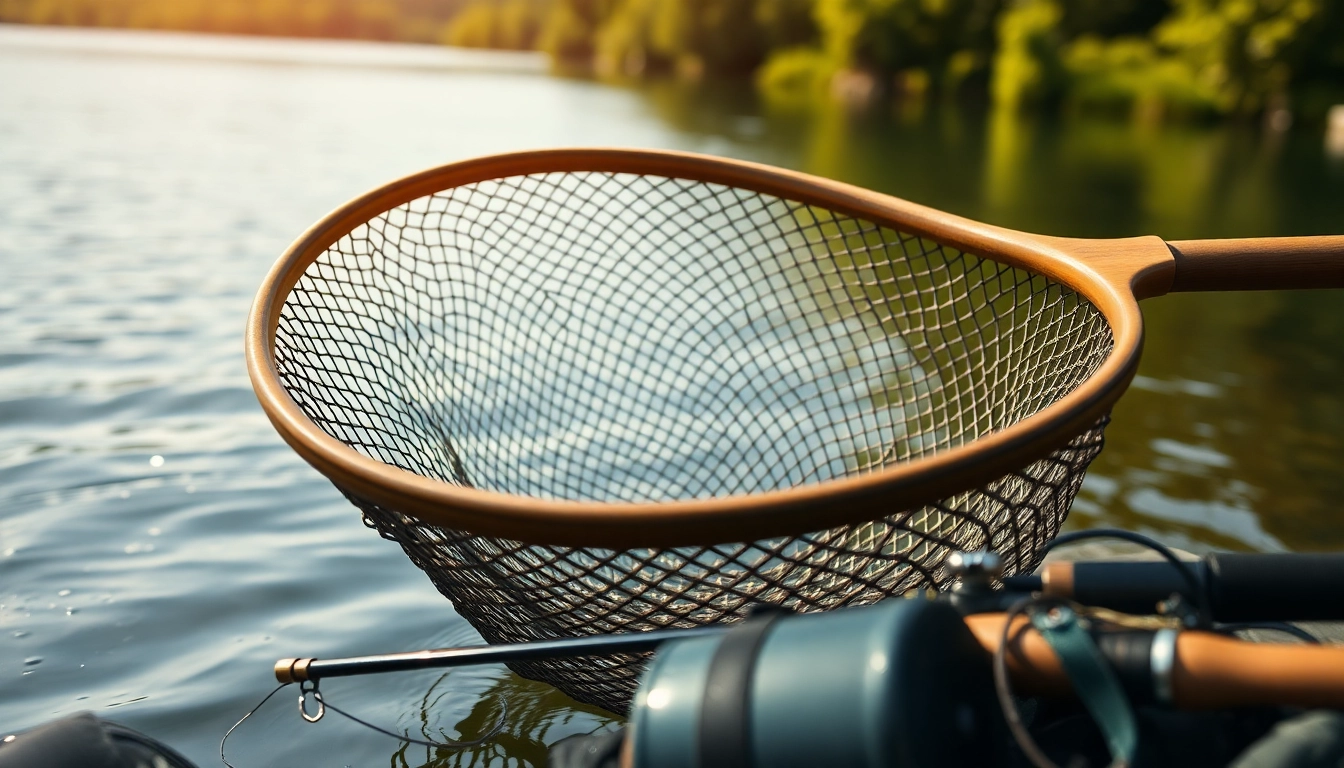Understanding Different Types of Fly Fishing Nets
For the passionate fly angler, a Fly fishing net is a critical piece of equipment that often goes overlooked in favor of more glamorous gear like rods and reels. Yet, the type of net you choose can significantly affect your fishing experience and success. From landing trout in a gentle creek to capturing a feisty bass in a larger body of water, understanding the various types of fly fishing nets available is essential for making an informed purchase.
Material Options for Fly Fishing Nets
The materials used in fly fishing nets can vastly influence their performance and durability. Common materials include:
- Wood: Wooden nets are often prized for their aesthetics. They provide a classic look and feel but can be heavier than nets made from synthetic materials.
- Aluminum: Lightweight and durable, aluminum nets are resistant to corrosion, making them ideal for saltwater fishing. They typically come in various colors and finishes.
- Carbon Fiber: Known for being exceptionally lightweight yet strong, carbon fiber nets combine the best of both worlds. They offer excellent maneuverability without sacrificing strength.
- Plastic: Affordable and lightweight, plastic nets come in multiple colors and shapes. However, they may lack the durability of aluminum or carbon fiber options.
Sizes and Shapes Explained
Choosing the right size and shape for your fly fishing net is crucial. Nets come in various sizes based on intended use:
- Small Nets: Typically ranging from 15 to 20 inches, these nets are great for small streams and delicate fishing situations.
- Medium Nets: Ranging from 20 to 25 inches, these nets work well for most freshwater species, including trout and panfish.
- Large Nets: Over 25 inches in size, these nets are designed for larger species like pike or bass and can accommodate catch-and-release practices.
- Shapes: The shape of the net can affect your catch-and-release efficiency. Rectangular nets allow easier landing of larger fish, while rounded nets are better for smaller species.
Best Features to Look For
When shopping for a fly fishing net, consider these key features:
- Rubber Mesh: A soft, rubberized mesh minimizes fish injury and prevents tangling, making it ideal for catch-and-release.
- Floating Handles: Many nets come with handles that are designed to float, ensuring that you won’t lose your net if it slips into the water.
- Ergonomic Handles: A comfortable grip is essential, especially during long fishing trips. Look for nets with ergonomic handles that provide better grip and control.
- Telescopic Features: Some nets feature telescopic handles that allow you to adjust their length based on your fishing needs, providing versatility in different environments.
Benefits of Using a Quality Fly Fishing Net
A good quality fly fishing net offers several advantages that enhance your fishing experience:
Minimizing Fish Injury
One of the primary benefits of using a well-designed fly fishing net is the ability to minimize injuries to the fish. Traditional nets often have rigid mesh designs that can cause harm to delicate fish skin. In contrast, modern nets typically utilize softer, rubberized mesh that cradles the fish securely while preventing it from slipping away. This element alone can make a significant difference in the survival rate of fish, particularly when practicing catch-and-release.
Efficiency in Catch and Release
Efficiency is key when it comes to catch-and-release techniques, especially for species that are sensitive to stress. A quality fly fishing net allows anglers to land fish quickly and safely, minimizing their exposure to air and handling time. Nets designed specifically for catch-and-release reduce injury potential and enhance the likelihood of survival—a crucial aspect for environmentally responsible anglers.
Enhancing Your Fishing Experience
The right net can significantly improve your overall fishing experience. Consider the ease with which you can land a fish, maneuver the net, and maintain balance while navigating rocky or slippery surfaces. A net that meets your fishing style and environment not only increases your success rate but also enhances the joy of fishing. Being able to land a fish with ease contributes to a more enjoyable time on the water.
Maintaining Your Fly Fishing Net
To extend the life of your fly fishing net, proper maintenance is essential. Here are some key maintenance guidelines:
Cleaning Techniques
After each fishing trip, it’s crucial to clean your net to remove any debris, algae, or contaminants that may contribute to wear over time:
- Freshwater Rinse: Always rinse your net with freshwater after use in saltwater or muddy conditions to prevent corrosion.
- Gentle Scrubbing: Use a soft brush to gently scrub the mesh and frame, focusing on any stubborn debris.
- Soap Solution: For deeper cleaning, use a mild soap solution to disinfect the net without harming the materials.
Storage Tips
How you store your net can significantly impact its durability. Keep these tips in mind:
- Dry Thoroughly: Ensure that your net is completely dry before storing it to prevent mold or mildew.
- Avoid Direct Sunlight: Store your net in a cool, shady place to avoid UV damage that can degrade the materials.
- Protection: If possible, store the net in a protective bag or case to prevent scratches and physical damage during transport.
When to Replace Your Net
Even the best nets have a lifespan. Here are signs it might be time to invest in a new net:
- Visible Wear: Check for frayed or damaged mesh, as it can increase the risk of losing your catch.
- Rust or Corrosion: If your net is made from metal, signs of rust might indicate it’s time for a replacement.
- Decreased Performance: If fishing feels awkward or difficult due to a poorly functioning net, it’s time to consider a new one.
Guidelines for Selecting a Fly Fishing Net
Selecting the right fly fishing net requires careful consideration of several factors. Here’s how to navigate the decision-making process:
Budget Considerations
While it may be tempting to choose the cheapest option available, investing in a quality fly fishing net can pay off in the long run. Assess your budget and determine how much you are willing to spend. Expect to pay higher for nets with advanced features, and which prioritizes fish care, durability, and efficiency. Establishing a budget helps narrow down your options while ensuring you invest in a product that suits your needs.
Reading Product Reviews
Before making a purchase, reading reviews can provide valuable insights into the performance and reliability of a net. Look for reviews from fellow anglers that highlight the net’s performance in various fishing conditions. Pay attention to comments regarding ease of use, durability, and overall satisfaction. These insights can help you make a more informed decision, ensuring that the net you choose doesn’t come with unexpected drawbacks.
Recommendations for Each Fishing Style
Different fishing styles may require different types of nets. Here’s a brief overview:
- Trout Fishing: Opt for smaller, lightweight nets with rubber mesh to minimize damage to trout.
- Saltwater Fishing: Choose heavy-duty nets made of corrosion-resistant materials to withstand harsher environments.
- Catch-and-Release Fishing: Focus on nets with a soft mesh that cradles the fish gently, increasing their chances of survival after release.
Where to Buy High-Quality Fly Fishing Nets
Once you’ve determined what type of fly fishing net you need, your next step is finding a reputable source. Here are some considerations:
Online vs. In-Store Shopping
Deciding whether to buy your net online or in a brick-and-mortar store comes down to personal preference:
- Online Shopping: Often offers a wider selection and better prices, along with convenient home delivery.
- In-Store Shopping: Provides the opportunity to physically inspect the net and seek advice from knowledgeable staff.
Top Retailers for Fly Fishing Gear
Look for well-known outdoor retailers that specialize in fishing gear. These retailers tend to have a greater selection and quality assurance. Research their offerings, especially those that focus specifically on fly fishing.
Evaluating Warranty and Return Policies
Before purchasing a net, take time to review the warranty and return policies. A solid warranty can safeguard your investment, while a customer-friendly return policy allows you to exchange or return the net if it doesn’t meet your expectations. It’s essential to ensure the retailer stands behind their product, which adds another layer of security to your purchase.



